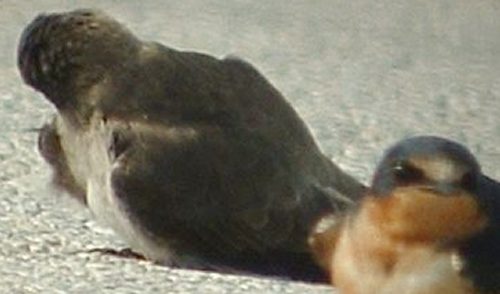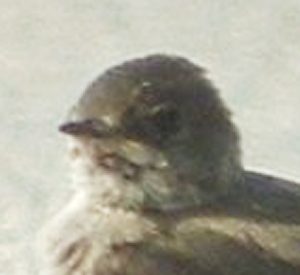
Update September 03, 2007: added some excellent photos of ridgwayi from the Yucatan, courtesy of Paul Donald - see bottom of page:
Update October 11 2003: I
found this weather image that adds to possibility that a ridgwayi
was displaced by a weather system just prior to the discovery
of the Benbrook swallow:

Analysis of the Rough-winged Swallow
found on October 03, 2003 at Benbrook Lake, near Fort Worth, Texas:
Quotes from "The Known Birds of North and Middle America" by Allan R. Phillips, 1986. Note that Phillips' key does not discuss
nor distinguish between subspecies within his two 'species' serripennis
and ridgwayi. The relevant parts for each form are placed
together for comparison:-
ridgwayi: "...with a dull whitish spot behind
the nostril (above the anterior end of the lores), sometimes extending
narrowly back toward eye (this spot less distinct in juv.)"
serripennis: "if somewhat paler above the lores,
this is most noticable toward the eye."
- This feature is quite obvious in the
Benbrook bird, and seems to be classic ridgwayi.
ridgwayi: "pale color of lower throat usually
(?) extends up sides of neck, contrasting somewhat to darker auriculars."
serripennis: "auriculars usually (?) little
or no darker than sides of neck, which are darker than throat."
- Look at the images on the original page;
a pale semi-collar behind the auricular is visible, and in the
the photo below it seems quite prominent:

ridgwayi: "Adults with longest pair of crissum
feathers nearly always solidly sooty subterminally (before the
narrow white tip); this sooty patch extends entirely across both
feathers from edge to edge and along each feather (maximum distance basad) 9.5mm or more.
It strongly approaches Blackish Neutral Gray (#82 of Smithe 1975)."
serripennis: "Crissum usually all white (always
white in juv?), the longest feathers sometimes with very narrow
darker shaft-streaks or, rarely, a dark fuscous spot (near Dark
Neutral Gray #83) extending no more than
7mm along the feather and hardly ever (?) entirely across
it."
ridgwayi: "Furca (longest minus central retrices)
of male 8-10.2 (11, 11.3)
mm, female 5.7-7.8 (8.5, 9.7);
1 juv 4.6. Hind toe and claw usually 8.5-9.5"
serripennis: "Furca (2.1) 3.4-6.1,
most females 2.5-4.5.Hind toe and claw (usually) 8-8.7."
- No measurements of the Benbrook Swallow
are available, but given the data in the photographs, some comparative
measurements can be made. The bird is standing close to/exactly
perpendicular to the camera, and in normal posture the hind toe
would be aligned with the axis of the body/tail. Consider these
images:


- It seems clear than the length of the
darkened undertail coverts exceeds the length of the hind claw-plus-toe;
according to Phillips' data, even on the rare serripennis
that has darker utcs, their extent is less than that of the hind
claw-plus-toe. This ratio on the Benbrook bird seems fine for
ridgwayi.


- While it is possible for the hind-claw
length to be foreshortened very slightly if the bird is not exactly
perpendicular, this would also shorten the tail cleft. Also, the
Furca measurement represents maximum difference between the central
and longest retrices, while the visible tail cleft will always
be shorter than this maximum - sometimes a great deal shorter.
Even so, using the above lines (in which the tail cleft is shorter
than the furca by an unknown amount), for this to be serripennis
it produces a cleft length at the extreme maximum quoted by Philips
for the furca (6.1mm) - assuming the shortest claw-plus-toe length
of 8mm. For a ridgwayi, this produces a cleft length of
6.5 - 7.3mm - comfortably in the range for female ridgwayi
(and allowing for the "cleft" vs "furca" difference, it could easily be a male).
Finally, here are wing measurements from "Swallows and Martins" by Turner and Rose:
serripennis: male 104-118mm; female 99-115mm.
fulvipennis: male 105-117mm; female 99-109mm.
psammochrous: male 105-112mm; female 100-107mm.
ridgwayi: male 116-122mm;
female 104-108mm.
stuarti: male/female 105-115mm.
American Barn Swallow Hirundo rustica erythrogaster:
male/female 114-126mm.
- Wing length can only be used as a general
indicator of size, yet it is clear that while all the other forms
are similarly "small", ridgwayi is significantly
larger - comparable to American Barn Swallow. The Benbrook Swallow
was very large for a Stelgidopteryx - easily the same size/bulk
as nearby Barn Swallows (indeed larger than some.) Note in the
image below that the Benbrook Swallow looks larger than the Barn
Swallow when both in front and behind it; this cannot be
explained by Photographic Size Illusion:

Thanks to Pete Hosner, here's pic of a presumed stuarti
(on range; Chiapas):

- and here's a comparison to the Benbrook Swallow I created, allowing
for the harsh lighting in Pete's photo (all tonal changes applied
to whole image):

Thanks to Bert Frenz, click
here for a pic of a presumed ridgwayi (on range;
Campeche); here's a modified version - but the shadow from the fluffed-out vent feathers
is preventing any detail being seen:

Added September 03, 2007: The following pics of ridgwayi were taken by Paul Donald at Chichen Itza, Yucatan, Mexico, in January 2007:



Compare below the loral area of the Yucatan ridgwayi (left) with the Fort Worth Roughwing (right):


Given the obvious very dark distal undertail coverts on the ridgwayi, it seems unlikely that the Fort Worth swallow is that taxon, however this Texas individual seems to challenge many of the claimed differences between the serripennis group and ridgwayi group...